Ridgeline returns to invade pickup mainstays
By John Gilbert
When you first spotted the Honda Ridgeline when it was introduced in 2005, you might have wondered what the heck it was, with its angular body panels and an appearance that was more like two-thirds of an SUV, with a pickup bed behind it.
There will be no such questions when you first see the new 2017 Ridgeline, which has been reintroduced with all of its popular and unique features updated, and the unusual angular body has been smoothed out into more conventional pickup truck shapes and contours.
It looks, simply, like a pickup truck, if less enormous than any standard full-size pickup. And that, presumably, is what Honda was after in this redesign of a truck that had been discontinued for three years, and possibly rendered to the antique lot.
In case you haven’t noticed, Honda is on a major revision of its full product line. Having already redesigned its basic engines, Honda has boldly announced that its Accord, Civic, CR-V and Odyssey will all be top sellers in their segments to individual consumers. Never mind lucrative fleet sales, Honda doesn’t sell to fleets, so it only counts individual sales because that is what individual customers purchase, rather than accepting a company car that might be nothing like what they wanted.
That specifically didn’t mention the Ridgeline, which makes sense, because nobody can intrude on the fantastic sales of Ford, Chevy and Ram pickups, although Toyota and Nissan keep trying, with impressive entries.
The new Ridgeline fits more into what modern life-style types might want — soul of a pickup, appearance of a pickup, interior of 2/3 of an SUV, an SUV’s versatility, maneuverability, foul-weather traction and comfortable ride and handling, but without the heft and enormity.
At a sticker price that ranges from $30,000 up to over $40,000, depending on how much connectivity and gadgetry 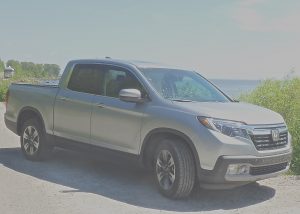 family requires, it might be the ideal second vehicle for a family that doesn’t demand a large pickup.
family requires, it might be the ideal second vehicle for a family that doesn’t demand a large pickup.
When Honda came out with the Ridgeline in 2005, it was a revolutionary product for the usually cautious Japanese auto company. This, after all, was a pickup truck, a purely American vehicle, and most Japanese companies found it comfortable to build vehicles Japan likes and sell them in the U.S.
But the Ridgeline made its own trail, when it was introduced as an angular, unusual, almost-full-size pickup. It defied pickup logic in several ways. Mainly, it was a unibody construction instead of strict body on frame, and second, its full-time all-wheel drive could maneuver itself into delivering all its power to the front wheels only, and whoever heard of a front-wheel-drive pickup?
Typical Honda, the interior was crammed full of useful features. Full, roomy rear seat, with a bench that flips up and locks against the backrest to enhance storage room enough to stash a bike back there. The bed itself was something else. While every company was trying to get buyers to also buy scratch and corrosion resistant bedliners, Honda made the entire bed out of composite material that wouldn’t scratch, bend or mutilate.
And then there was the rear of the bed, which opened with a normal tailgate, or could be opened from the side, right to left, for ease in loading certain items. That, too, was not all. At the rear edge of the bed’s floor, there was a hand grip. Pull it and you could open it like a trap door down to the cellar.
The bin itself, also of bullet-proof composite, could be filled with any and all manner of stuff, from a set of golf clubs to any valuable tools, or tomorrow’s lunch. Anything you considered too valuable to swipe you could lock away in that handy little hatch and still have the bed to fill.
OK, so why are we spending so much time dwelling on the 12-year-old original Ridgeline? After all, Honda discontinued making it, as though it was capitulating from the segment. Along about then, Chevrolet came out with the Colorado, and GMC with the partnering Canyon, and midsize trucks were in vogue again, and not just the Toyota Tacoma and Nissan Frontier.
So it’s perfect timing for Honda to bring back the family-friendly Ridgeline, because it’s not quite as big as full size, and maybe it’s a tug longer than midsize.
It’s also wise mainly because all of those captivating features from the original are duplicated on the newly restyled 2017 model Ridgeline. Except one: the unusual shapes, contours and body panels of the original are gone.
Strangely, only the buyers of the original Ridgeline might complain about the new look. I never thought the original looked bad, and it grew on me over the years, even while hard-core truck guys grumbled and criticized it for being a lightweight boxer entering a heavyweight slugfest.
When it comes to pickup trucks, many people need full-size for work, and many others want full size for towing/hauling. But probably 85 percent of all pickup buyers end up buying a bigger truck than they need, just because the big trucks are so macho, so impressive, so powerful and so feature-filled.
But the Ridgeline is 210 inches long — about two or three feet shorter than the main full-size pickups — and it weighs 4,510 pounds — basically 100-2,300 pounds less than its bigger adversaries. That means you don’t need a big V8, or even a small V8, or a turbo-diesel to get your pickup moving. The Ridgeline will move all four wheels very smartly with a 280-horsepower, 262-foot-pounds of torque V6 engine, highly sophisticated as it powers all four wheels with computerized selectivity.
The less-squared, less-angular Ridgeline can be bought with either front-wheel drive or Honda’s high-tech all-wheel drive, and it should deliver fuel economy in the mid-20s while working.
The term “working” means other things to a Ridgeline, also. It won’t tow 9-11,000-pound trailers that full-size trucks can, but it does tow 5,000 pounds, which might take care of the fishing boat and trailer, and 90 percent of the workloads people buy bigger trucks to haul.
What I noticed most about the Ridgeline is that driving it is smooth and almost quiet, unlike most pickups. And through a slalom course, the Ridgeline would undoubtedly prove itself to be the best-handling pickup in agility drills.
I also noticed some distinct similarities to the superb Honda Pilot SUV, and with good reason. Its independent rear suspension features the same torque-vectoring control in curves that the Pilot and Acura MDX deploy, and the nose of the Ridgeline has a family resemblance.
If I were shopping for a pickup truck, I would want something that would haul the family in SUV-type comfort and class in most cases, but handle light hauling and-or light towing duties when necessary — never mind the heavy-duty stuff. The Ridgeline handles that challenge very easily.
And just so you don’t overlook that cleverly designed trunk in the pickup box, consider going off on a family picnic. You simply load a couple buckets of crushed ice into the “trunk,” and put your pop and food in with it. When you get to the picnic area, unload what you need from the watertight compartment, and when you get ready to leave, turn the petcock and drain the melting water out before you head home.
You could even check the draining water for any invasive species, although, come to think of it, that might be the perfect term makers of conventional pickups might call the Ridgeline.


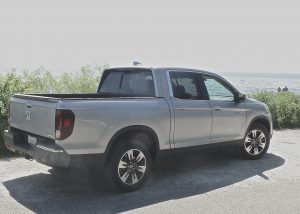
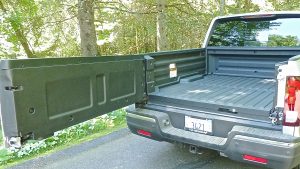
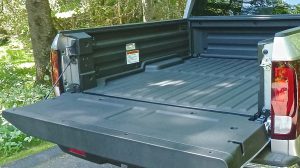
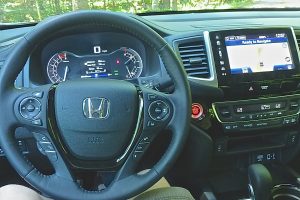
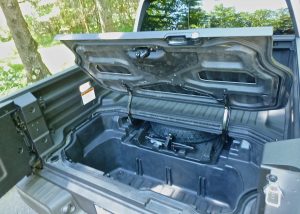
 John Gilbert is a lifetime Minnesotan and career journalist, specializing in cars and sports during and since spending 30 years at the Minneapolis Tribune, now the Star Tribune. More recently, he has continued translating the high-tech world of autos and sharing his passionate insights as a freelance writer/photographer/broadcaster. A member of the prestigious North American Car and Truck of the Year jury since 1993. John can be heard Monday-Friday from 9-11am on 610 KDAL(www.kdal610.com) on the "John Gilbert Show," and writes a column in the Duluth Reader.
John Gilbert is a lifetime Minnesotan and career journalist, specializing in cars and sports during and since spending 30 years at the Minneapolis Tribune, now the Star Tribune. More recently, he has continued translating the high-tech world of autos and sharing his passionate insights as a freelance writer/photographer/broadcaster. A member of the prestigious North American Car and Truck of the Year jury since 1993. John can be heard Monday-Friday from 9-11am on 610 KDAL(www.kdal610.com) on the "John Gilbert Show," and writes a column in the Duluth Reader.